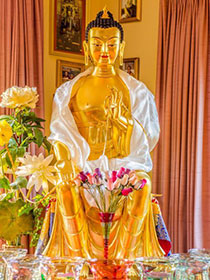- Home
- FPMT Homepage
Foundation for the Preservation of the Mahayana Tradition
The FPMT is an organization devoted to preserving and spreading Mahayana Buddhism worldwide by creating opportunities to listen, reflect, meditate, practice and actualize the unmistaken teachings of the Buddha and based on that experience spreading the Dharma to sentient beings. We provide integrated education through which people’s minds and hearts can be transformed into their highest potential for the benefit of others, inspired by an attitude of universal responsibility and service. We are committed to creating harmonious environments and helping all beings develop their full potential of infinite wisdom and compassion. Our organization is based on the Buddhist tradition of Lama Tsongkhapa of Tibet as taught to us by our founders Lama Thubten Yeshe and Lama Thubten Zopa Rinpoche.
- Willkommen
Die Stiftung zur Erhaltung der Mahayana Tradition (FPMT) ist eine Organisation, die sich weltweit für die Erhaltung und Verbreitung des Mahayana-Buddhismus einsetzt, indem sie Möglichkeiten schafft, den makellosen Lehren des Buddha zuzuhören, über sie zur reflektieren und zu meditieren und auf der Grundlage dieser Erfahrung das Dharma unter den Lebewesen zu verbreiten.
Wir bieten integrierte Schulungswege an, durch denen der Geist und das Herz der Menschen in ihr höchstes Potential verwandelt werden zum Wohl der anderen – inspiriert durch eine Haltung der universellen Verantwortung und dem Wunsch zu dienen. Wir haben uns verpflichtet, harmonische Umgebungen zu schaffen und allen Wesen zu helfen, ihr volles Potenzial unendlicher Weisheit und grenzenlosen Mitgefühls zu verwirklichen.
Unsere Organisation basiert auf der buddhistischen Tradition von Lama Tsongkhapa von Tibet, so wie sie uns von unseren Gründern Lama Thubten Yeshe und Lama Thubten Zopa Rinpoche gelehrt wird.
- Bienvenidos
La Fundación para la preservación de la tradición Mahayana (FPMT) es una organización que se dedica a preservar y difundir el budismo Mahayana en todo el mundo, creando oportunidades para escuchar, reflexionar, meditar, practicar y actualizar las enseñanzas inconfundibles de Buda y en base a esa experiencia difundir el Dharma a los seres.
Proporcionamos una educación integrada a través de la cual las mentes y los corazones de las personas se pueden transformar en su mayor potencial para el beneficio de los demás, inspirados por una actitud de responsabilidad y servicio universales. Estamos comprometidos a crear ambientes armoniosos y ayudar a todos los seres a desarrollar todo su potencial de infinita sabiduría y compasión.
Nuestra organización se basa en la tradición budista de Lama Tsongkhapa del Tíbet como nos lo enseñaron nuestros fundadores Lama Thubten Yeshe y Lama Zopa Rinpoche.
A continuación puede ver una lista de los centros y sus páginas web en su lengua preferida.
- Bienvenue
L’organisation de la FPMT a pour vocation la préservation et la diffusion du bouddhisme du mahayana dans le monde entier. Elle offre l’opportunité d’écouter, de réfléchir, de méditer, de pratiquer et de réaliser les enseignements excellents du Bouddha, pour ensuite transmettre le Dharma à tous les êtres. Nous proposons une formation intégrée grâce à laquelle le cœur et l’esprit de chacun peuvent accomplir leur potentiel le plus élevé pour le bien d’autrui, inspirés par le sens du service et une responsabilité universelle. Nous nous engageons à créer un environnement harmonieux et à aider tous les êtres à épanouir leur potentiel illimité de compassion et de sagesse. Notre organisation s’appuie sur la tradition guéloukpa de Lama Tsongkhapa du Tibet, telle qu’elle a été enseignée par nos fondateurs Lama Thoubtèn Yéshé et Lama Zopa Rinpoché.
Visitez le site de notre Editions Mahayana pour les traductions, conseils et nouvelles du Bureau international en français.
Voici une liste de centres et de leurs sites dans votre langue préférée
- Benvenuto
L’FPMT è un organizzazione il cui scopo è preservare e diffondere il Buddhismo Mahayana nel mondo, creando occasioni di ascolto, riflessione, meditazione e pratica dei perfetti insegnamenti del Buddha, al fine di attualizzare e diffondere il Dharma fra tutti gli esseri senzienti.
Offriamo un’educazione integrata, che può trasformare la mente e i cuori delle persone nel loro massimo potenziale, per il beneficio di tutti gli esseri, ispirati da un’attitudine di responsabilità universale e di servizio.
Il nostro obiettivo è quello di creare contesti armoniosi e aiutare tutti gli esseri a sviluppare in modo completo le proprie potenzialità di infinita saggezza e compassione.
La nostra organizzazione si basa sulla tradizione buddhista di Lama Tsongkhapa del Tibet, così come ci è stata insegnata dai nostri fondatori Lama Thubten Yeshe e Lama Zopa Rinpoche.
Di seguito potete trovare un elenco dei centri e dei loro siti nella lingua da voi prescelta.
- 欢迎 / 歡迎
简体中文
“护持大乘法脉基金会”( 英文简称:FPMT。全名:Foundation for the Preservation of the Mahayana Tradition) 是一个致力于护持和弘扬大乘佛法的国际佛教组织。我们提供听闻,思维,禅修,修行和实证佛陀无误教法的机会,以便让一切众生都能够享受佛法的指引和滋润。
我们全力创造和谐融洽的环境, 为人们提供解行并重的完整佛法教育,以便启发内在的环宇悲心及责任心,并开发内心所蕴藏的巨大潜能 — 无限的智慧与悲心 — 以便利益和服务一切有情。
FPMT的创办人是图腾耶喜喇嘛和喇嘛梭巴仁波切。我们所修习的是由两位上师所教导的,西藏喀巴大师的佛法传承。
繁體中文
護持大乘法脈基金會”( 英文簡稱:FPMT。全名:Found
ation for the Preservation of the Mahayana Tradition ) 是一個致力於護持和弘揚大乘佛法的國際佛教組織。我們提供聽聞, 思維,禪修,修行和實證佛陀無誤教法的機會,以便讓一切眾生都能 夠享受佛法的指引和滋潤。 我們全力創造和諧融洽的環境,
為人們提供解行並重的完整佛法教育,以便啟發內在的環宇悲心及責 任心,並開發內心所蘊藏的巨大潛能 — 無限的智慧與悲心 – – 以便利益和服務一切有情。 FPMT的創辦人是圖騰耶喜喇嘛和喇嘛梭巴仁波切。
我們所修習的是由兩位上師所教導的,西藏喀巴大師的佛法傳承。 察看道场信息:
- FPMT Homepage
- News/Media
-
- Study & Practice
-
-
- About FPMT Education Services
- Latest News
- Programs
- New to Buddhism?
- Buddhist Mind Science: Activating Your Potential
- Heart Advice for Death and Dying
- Discovering Buddhism
- Living in the Path
- Exploring Buddhism
- FPMT Basic Program
- FPMT Masters Program
- FPMT In-Depth Meditation Training
- Maitripa College
- Lotsawa Rinchen Zangpo Translator Program
- Universal Education for Compassion & Wisdom
- Online Learning Center
-
- Prayers & Practice Materials
- Overview of Prayers & Practices
- Full Catalogue of Prayers & Practice Materials
- Explore Popular Topics
- Benefiting Animals
- Chenrezig Resources
- Death & Dying Resources
- Lama Chopa (Guru Puja)
- Lama Zopa Rinpoche: Compendium of Precious Instructions
- Lama Zopa Rinpoche: Life Practice Advice
- Lama Zopa Rinpoche Practice Series
- Lamrim Resources
- Mantras
- Prayer Book Updates
- Purification Practices
- Sutras
- Thought Transformation (Lojong)
- Audio Materials
- Dharma Dates - Tibetan Calendar
- Translation Services
- Publishing Services
- Ways to Offer Support
- Prayers & Practice Materials
-
- Teachings and Advice
- Find Teachings and Advice
- Lama Zopa Rinpoche Advice Page
- Lama Zopa Rinpoche: Compendium of Precious Instructions
- Lama Zopa Rinpoche Video Teachings
- ༧སྐྱབས་རྗེ་བཟོད་པ་རིན་པོ་ཆེ་མཆོག་ནས་སྩལ་བའི་བཀའ་སློབ་བརྙན་འཕྲིན།
- Podcasts
- Lama Yeshe Wisdom Archive
- Buddhism FAQ
- Dharma for Young People
- Resources on Holy Objects
- Teachings and Advice
-
-
*If a menu item has a submenu clicking once will expand the menu clicking twice will open the page.
-
-
- Centers
-
- Teachers
-
- Projects
-
-
-
-
*If a menu item has a submenu clicking once will expand the menu clicking twice will open the page.
-
-
- FPMT
-
-
-
-
-
Right understanding is the only solution to both physical and mental problems. You should always check very carefully how you’re expending your energy: will it make you happy or not? That’s a big responsibility, don’t you think? It’s your choice: the path of wisdom or the path of ignorance.
Lama Thubten Yeshe
-
-
-
- Shop
-
-
-
The Foundation Store is FPMT’s online shop and features a vast selection of Buddhist study and practice materials written or recommended by our lineage gurus. These items include homestudy programs, prayers and practices in PDF or eBook format, materials for children, and other resources to support practitioners.
Items displayed in the shop are made available for Dharma practice and educational purposes, and never for the purpose of profiting from their sale. Please read FPMT Foundation Store Policy Regarding Dharma Items for more information.
-
-
Lama Zopa Rinpoche News and Advice
22
The Power of Mantra
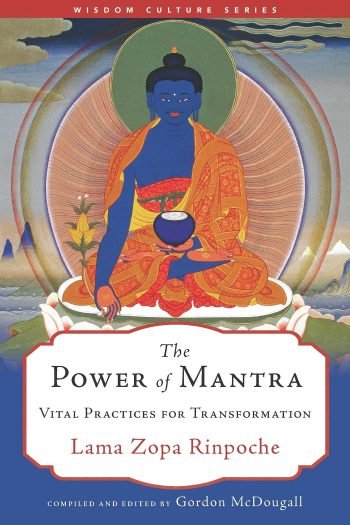
The Sanskrit word mantra (which is ngag in Tibetan) has two syllables: man, which means “mind,” and tra, which means “protect,” so a mantra is something that protects our mind.
The benefits of mantra recitation are vast. There are many stories about terrible diseases such as cancer being cured by mantras, or people or animals being helped to have a peaceful death and a positive rebirth through mantras being recited to them. But the supreme benefit of a mantra is its ability to transform our mind. When we recite a mantra such as Shakyamuni’s mantra, we are recalling the Buddha’s name over and over, helping us increase our closeness and devotion to the Buddha, and devotion is our real protection from suffering. By transforming our mind, it has the power to break negative habits and develop positive ones. As our mind changes, our ability to help others increases, so we are reciting mantras for others as well.
By linking us to the omniscient mind—the wisdom and compassion of the Buddha and all the enlightened beings—reciting a mantra invokes that great power, leading us from nonvirtue to virtue. The Buddha said,
Do not commit any nonvirtuous actions,
perform only perfect virtuous actions,
subdue your mind thoroughly—
this is the teaching of the Buddha.
The whole Buddhist path comes down to these two pieces of advice—to not harm others and to benefit them. In order to do that, we must subdue the mind, which means both collecting merit through doing only virtuous actions and purifying any negative imprints on our mindstream from negative actions we have done in the past.
Reciting a mantra such as OM MANI PADME HUM, the mantra of Chenrezig, is not only the most unbelievable purification—purifying defilements and negative karmas collected from not just this life but from beginningless rebirths—it also collects extensive merits.
In the West, when soccer players win, they throw their arms up in the air and run around. It’s very intense. When I first saw this, I thought they were very angry because of the strong emotion. If they feel that strongly about winning a match, we should feel a billion times more strongly about being able to purify all that negative karma and accumulate all that merit, simply by reciting a mantra.
Westerners have asked me many times to explain how mantras work. This is a question that comes from the Western mind; it’s not asked in Asia, certainly not among the Tibetans, because they have faith. When there is water, what does water do? It makes things wet; that is its nature. Fire has its own nature; its nature is to burn. Everything has its own nature. Mantras too have their own nature; their nature is to transform the mind. Any word we say affects another person’s mind, making them happy or sad or angry or whatever. The power of the mantra comes from the sound, and that sound has the power to transform the mind into one of virtue.
Thinking of mantras as just some Sanskrit sounds to be chanted is an extremely limited view of what they are; they are much more than that. The sound of a mantra has the power to protect us, holding our mind from nonvirtuous thoughts and fostering virtuous ones, thus allowing us to develop toward enlightenment. In the same way that the Dharma in general holds us, protecting us from suffering—Dharma literally means “that which holds”—mantras are mind protection. In A Guide to the Bodhisattva’s Way of Life, the great being Shantideva said,
Therefore, I should focus my mind correctly,
and keep a careful watch over it.
What good will it do to keep many vows,
if one neglects the vow of watching over the mind?
It is vital to remember Shantideva’s advice. If we forget to protect our mind, what is the use of any traditional form of discipline? Even though we may do hundreds of other things, if we leave out this most important practice and leave the mind unprotected, we cannot stop our problems and achieve happiness, especially ultimate happiness. Everything comes from the mind; it is the source of all our suffering and all our happiness, so if we neglect to protect our mind, we cannot close the door to suffering or open it to happiness.
In the West, there are so many external rules: you can’t do this, you can’t do that. Sometimes I think there are too many rules. When we rely on external discipline, we can never solve our problems. The discipline has to come from our own mind. As a Buddhist, we might take certain vows to protect ourselves from committing any of the ten nonvirtuous actions, but unless we protect our mind, those vows will be impossible to keep. As Shantideva said, what good will having vows be if we can’t watch over our mind?
Modern Western life is full of distractions. Everywhere are objects of the senses to keep our mind busy, enticing us away from the Dharma. If you check you will see this is true. Being preoccupied with working for this worldly life, as so many people are, makes it extremely difficult to remember the necessity of Dharma practice and to find the time to practice it. Buddhism has many methods to overcome a distracted mind, such as meditating on impermanence and death or on the disadvantages of the self-cherishing mind. When we are not meditating, however, what is the best method? Reciting mantras will keep our mind in virtue and protect it from nonvirtue.
From The Power of Mantra: Vital Practices for Transformation by Lama Zopa Rinpoche; compiled and edited by Gordon McDougall; published by Wisdom Publications (WisdomExperience.org), where you can order the paperback or digital versions of the book. You can also find the ebook and PDF version in the Foundation Store (shop.fpmt.org).
Lama Zopa Rinpoche is the spiritual director of the Foundation for the Preservation of Mahayana Tradition (FPMT), a Tibetan Buddhist organization dedicated to the transmission of the Mahayana Buddhist tradition and values worldwide through teaching, meditation and community service.
- Tagged: lama zopa rinpoche, mantras, wisdom publications
17
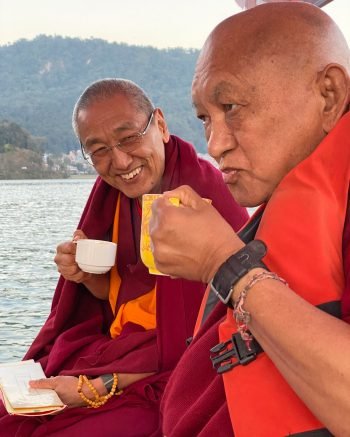
Rinpoche and Khen Rinpoche Geshe Chonyi, enjoying tea on the lake in Pokhara after blessing the sentient beings in the lake, Pokhara, Nepal, December 2021. Photo by Ven. Roger Kunsang.
We can do many things with our perfect human rebirth. Lama Zopa Rinpoche consistently reminds us to not waste this human rebirth but use it to develop compassion and help others. Here is an excerpt of Rinpoche’s teachings on this topic from “The Time to Practice is Now,” a detailed summary of the 2020 Thought Transformation Teachings given by Rinpoche. Then, following the excerpt, is a short video of Rinpoche teaching on this topic.
By reflecting on our own samsara and realizing that we have experienced oceans of suffering from beginningless rebirths, we develop strong renunciation wishing to be free from it. When we also think that others are suffering in the same way, we develop compassion for them, wishing them to be free from suffering. While we are just one, they are numberless—and they suffer just like us. We can’t imagine the different kinds of suffering that other beings experience. It is unbearable.
To generate compassion, we need to know the suffering of the six-realm sentient beings. For example, pretas, or hungry ghosts (a type of being), can’t find food or drink for tens of thousands of years. Due to their karma, even if they see water, their gaze dries the water up and it disappears. If they look at a green plant, it becomes bare and wilted. One type of preta has a mouth the size of the eye of a needle, but a stomach as big as a mountain. Even if they find food or drink, it cannot fill their stomachs. A second type of preta has flames coming from its mouth, and a third type has knots in its neck. These pretas all have unimaginable, unbearable suffering. One practice Rinpoche does often is making charity to these pretas by combining the practice with Dzambala offering, utilizing the offered water for the pretas.
As human beings, we cannot stand even small problems and difficulties. But these hardships are nothing compared to those experienced by animals. They cannot express themselves, so there is no one to help them. In addition, human beings, from presidents and billionaires down to beggars, do not really comprehend the feelings of animals. We kill thousands of animals every day for food. People not only eat them, but also make money from killing them and selling their meat and other body parts including skin and fur. People have the mistaken view that this is a good thing, that there is nothing wrong with it, that these beings are there for our pleasure. They never think about the suffering of the animals and that they also want happiness. They don’t realize that these beings, who have been their mother’s numberless times, are objects of compassion, not simply objects of pleasure.
We, therefore, need to develop compassion for animals and help them. There are many ways to benefit animals, who may suffer in the animal realm not just for this one lifetime, but for many eons. In his teachings, Rinpoche offers examples of how to cherish all sentient beings, including even the tiniest (and most irritating!) among us, such as mosquitoes. Some ideas of ways to benefit them include offering them blessed water or food, reciting prayers and mantras to them, playing sutras for them to hear, taking them around holy objects, and so forth. We can also build holy objects that animals can circumambulate to collect merit.
Wherever we go we can benefit sentient beings. For example, when we go to the beach, we can benefit all the animals in the ocean by dedicating our merits for them to never again be reborn in the lower realms and to be free from physical and mental sufferings, and for all of their wishes to succeed according to holy Dharma. Also, while at the beach, we can pray for human beings, wishing that anyone who even hears about the beach, sees the beach, or remembers the beach be free from all suffering and achieve all happiness, including enlightenment.
Watch the Essential Extract “How to Help Sentient Beings Say Goodbye to the Suffering of Samsara”:
In this video Essential Extract, Lama Zopa Rinpoche describes some of the ways in which he helps animals as well as people say goodbye to suffering. For example, in California, Rinpoche, together with sangha, goes to a pier over the ocean and dips a board, on which is carved the Namgyalma mantra, into the ocean. Before that, Rinpoche also recites mantras and blows on some water to bless it, and then pours the water in the ocean to purify the sentient beings living in it. Rinpoche also recites the long Chenrezig mantra and whenever he puts his feet in an ocean or lake, the water becomes blessed and anyone who is touched by it is purified. When Rinpoche goes to a beach, he makes prayers that anyone who comes to the beach, or even hears about or sees the beach, is never again reborn in the lower realms, that all their wishes succeed according to holy Dharma, and that they actualize bodhicitta and achieve enlightenment.
Read the transcript of this video extract from Rinpoche’s teaching:
https://fpmt.box.com/s/w2zmr2lgs6ag94xtccgcg4ua4nn6bsft
You can find more blogs with short video clips from Rinpoche’s teaching as well as the complete collection of these “Essential Extracts” videos on FPMT.org.
Lama Zopa Rinpoche is the spiritual director of the Foundation for the Preservation of Mahayana Tradition (FPMT), a Tibetan Buddhist organization dedicated to the transmission of the Mahayana Buddhist tradition and values worldwide through teaching, meditation and community service.
- Tagged: advice from lama zopa rinpoche, animals, essential extract, essential extract thought transformation teachings, namgyalma mantra, perfect human rebirth, video
14
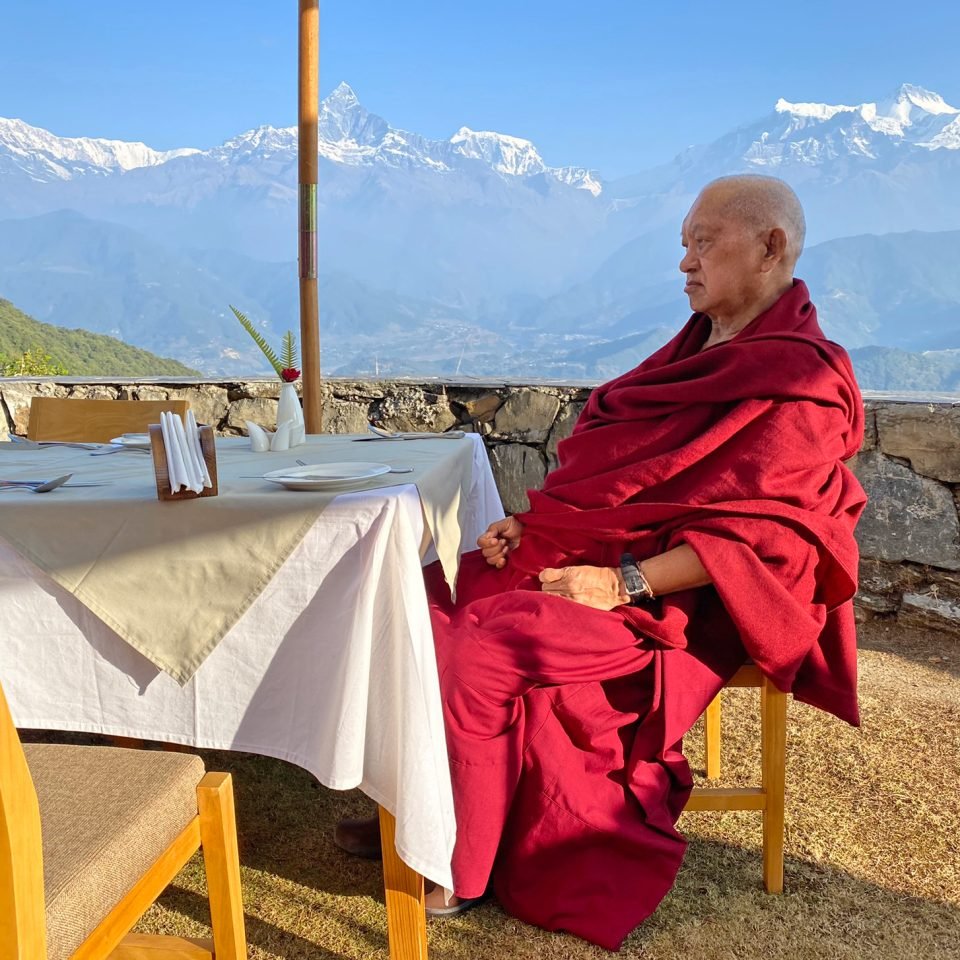
Lama Zopa Rinpoche with views of Annapurna and the Himalayan Mountains, Pokhara, Nepal, December 2021. Photo by Ven. Roger Kunsang.
We can engage in many beneficial activities with our perfect human rebirth. Those activities include generating the four immeasurable thoughts, overcoming self-cherishing, living life with a good heart, and cherishing others. Here are short summaries of Rinpoche’s teachings on these beneficial activities from “The Time to Practice is Now,” a detailed overview of the 2020 Thought Transformation Teachings given by Rinpoche. A short video of Rinpoche teaching on this topic follows the excerpt.
We Can Use Our Perfect Human Rebirth to Generate the Four Immeasurable Thoughts
This perfect human rebirth is so precious because it can be used to practice the four immeasurable thoughts. The merit of practicing each of the four immeasurable thoughts—immeasurable equanimity, immeasurable loving kindness, immeasurable compassion, and immeasurable joy—is so huge that it doesn’t fit in the sky. Rinpoche advises us to not just recite the words of the prayer for generating the four immeasurable thoughts—while thinking of eating pizza or going to the beach!—but to actually meditate on them. To illustrate the benefits of doing so, Rinpoche talks extensively about the benefits of generating immeasurable loving kindness. For example, King of Concentration Sutra says that the merit of generating loving kindness far exceeds the merit of making unimaginable offerings to all the supreme holy beings in ten million billion universes! Meditation on the four immeasurables combined with doing tonglen is especially amazing.
We Can Use Our Perfect Human Rebirth to Overcome Self-Cherishing
This perfect human rebirth is also so precious because we can use it to overcome our self-cherishing thought, our selfish mind, and generate loving kindness, compassion, and bodhicitta. This is much more meaningful than living our life under the control of delusions and causing harm to sentient beings. Usually when someone harms us, our solution is to harm them back, and because of this, we continuously receive harm. The self-cherishing thought that thinks, “I am most important, my happiness is most important,” is a total hallucination. It is like drinking poison while believing it is nectar and only causes us to harm ourselves and others.
The self-cherishing mind is also like a rock. We have to make it soft like cotton—full of loving-kindness and great compassion for others—which leads to bodhicitta. In addition, the self-cherishing mind is like a dictator which only thinks about our own happiness and our own power. We don’t want anyone to harm us or be displeased with us. Because of that, if someone harms, insults, or criticizes us, we get so upset because the self-cherishing mind didn’t get what it wanted. This self-cherishing is the real enemy because all of the suffering of samsara from beginningless rebirths up until now comes from thinking in this way. Together with self-grasping, it has prevented us from achieving even one realization of the path to enlightenment and from liberating even one single sentient being from samsara.
Living our life controlled by the self-cherishing thought, anger, attachment, and the root of samsara—the ignorance holding the I as real—has cheated us. We think of “me, me, me” and work only for ourselves, but all of our happiness comes from sentient beings. Also, Buddha, Dharma, and Sangha, in whom we take refuge, come from sentient beings. Therefore, we should see all sentient beings as dear and use this precious opportunity of a human life to abandon self-cherishing and strengthen the mind that cherishes others more than ourselves.
We Can Use Our Perfect Human Rebirth to Live Life with a Good Heart and Cherish Others
It is so important to live our life with a good heart, not harming sentient beings and only benefiting them. First we come to realize that everyone’s happiness is as important as our own; and next we come to realize that their happiness is more important than our own.
There are many benefits of using our precious human rebirth to cherish others. If we want happiness, it has to come from our mind, Rinpoche explains. Buddha defeated a million maras by meditating on loving-kindness. If we practice loving-kindness, if we practice bodhicitta, this is the best protection from life’s dangers. If we don’t want suffering—don’t harm others! If a person dedicates their life and offers service with a good heart to everyone, not in a forced way but happily and sincerely, then everything appears to that person as happy, everything appears as good. Therefore, it is also in our own self-interest to cherish others.
Generating loving kindness and compassion, and avoiding the self-cherishing mind is also unbelievably important for our health. With a good heart, we can achieve success for ourselves and others. We can cease all the wrong concepts and delusions,
Watch the Essential Extract “You Get Skies of Merits by Meditating on Immeasurable Loving Kindness”:
In this short video Essential Extract, Lama Zopa Rinpoche explains that our perfect human rebirth is precious because we can use it to generate loving kindness. Rinpoche then recites the short prayer for generating loving kindness and explains its significance. As Rinpoche says, “Even generating loving kindness just for a very short time, a few seconds or a minute, wow, wow, wow, amazing, amazing, wow, wow, the benefits, the merits that you get, wow, wow.” However, if we don’t understand this, we won’t like doing prayers and instead will spend our life involved in negative karma.
Read the transcript of this video extract from Rinpoche’s teaching:
https://fpmt.box.com/s/dfc9e1a70z2rqmmbhh7dufeddfl22cl7
You can find more blogs with short video clips from Rinpoche’s teaching as well as the complete collection of these “Essential Extracts” videos on FPMT.org.
Read more on this topic in Lama Zopa Rinpoche’s book The Perfect Human Rebirth: Freedom and Richness on the Path to Enlightenment, published by Lama Yeshe Wisdom Archive (LamaYeshe.com). You can find the four immeasurable thoughts in the Daily Prayers booklet, available in ebook and PDF format in the Foundation Store (shop.fpmt.org).
Lama Zopa Rinpoche is the spiritual director of the Foundation for the Preservation of Mahayana Tradition (FPMT), a Tibetan Buddhist organization dedicated to the transmission of the Mahayana Buddhist tradition and values worldwide through teaching, meditation and community service.
- Tagged: advice from lama zopa rinpoche, essential extract, essential extract thought transformation teachings, perfect human rebirth, video
8
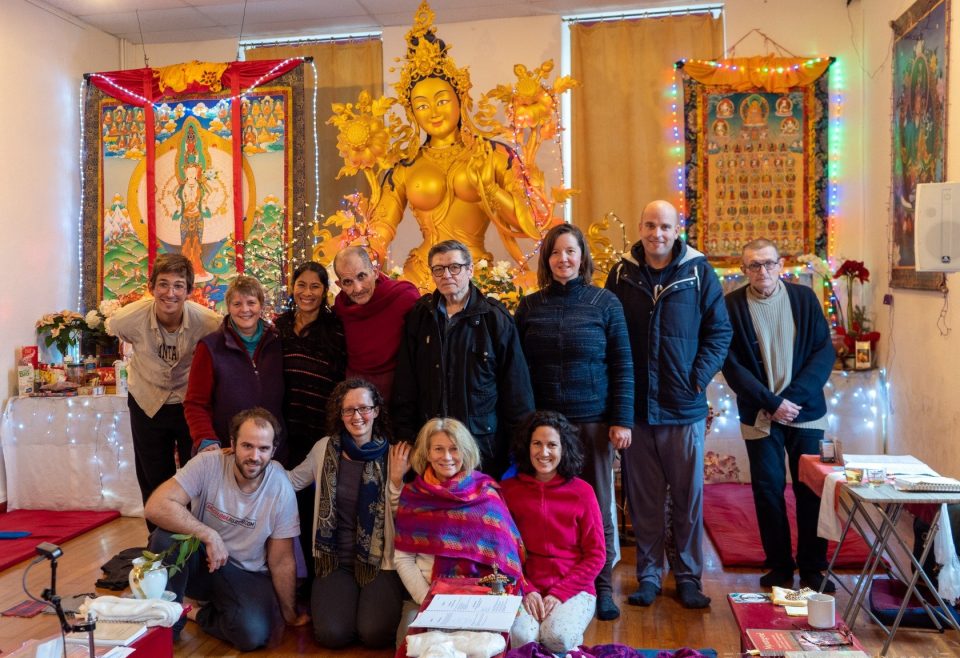
Some of the 2021-2022 nyung-na retreat participants at IVY. Photo by Tsanka Petkova
Institut Vajra Yogini (IVY), France, began hosting their eleventh 108 Nyung-Na Retreat in November 2021. Despite precautions taken before the start of the retreat, and adhering to local protocols once the retreat began, in January one retreatant tested positive for the coronavirus. Then each participant became sick one by one, and the virus spread to the wider IVY community as well.
The nyung-nas were paused upon learning about the spread among retreatants. After two weeks and negative tests from all participants, the retreat began again on January 31. Only eight nyung-nas were missed during this break, and some retreatants may still complete one hundred nyung-nas during this 2021-2022 series. The continuity of this seven month series of 108 nyung-nas was not broken as one of the retreatants managed to continue the practice alone during the break. Please rejoice!
Lama Zopa Rinpoche sent the IVY community advice on how to use the virus to attain enlightenment. This is timely advice for students around the world who are still dealing with the negative effects of this pandemic:
My most dear, most precious, treasure of Vajrayogini, Geshe Loden Rinpoche, and then my most dear, all the Vajrayogini brothers and sisters, everybody who are in the Vajrayogini mandala,
So Geshe Loden explained everyone got this very precious virus.
So I want to mention what Kadampa Geshe Khamlungpa said: Even this present little suffering, it finishes the past heavy negative karmas, and in the future will turn out happiness. Therefore rejoice, be happy that you are experiencing this suffering.
Therefore, you received the virus, so be happy—happy, hippie, not hippie, happy, hippie already years ago. I am bringing back hippie life now.
So the benefits are incredible. By experiencing this now, it finishes so many heavy negative karmas, from so many past lives. Wow! Can you imagine from beginningless rebirth, so many heavy negative karmas? It makes to finish them, so that is the benefit.
Otherwise, you have to be in the lower realm, and for eons and eons you have to suffer in the cold hells, in the hot hells, all those major and secondary hells. Wow, wow, wow, wow, wow, wow, wow! Can you imagine?
So this experience, this virus, it makes to finish all the past heavy negative karma. So what happens in the future is that you will be like the sun shining in the world. So, everybody, people, animals, enjoy the sun rising in the whole world. Then there will be so much happiness. From life-to-life you will go to enlightenment.
Then, there are many other benefits from experiencing suffering. There are many other benefits, but I just mention this much.
The other most important thing you have to know is that bad and good is not outside. It is up to your mind; whatever happens in your life, bad or good, is up to your mind. Like when you change the TV channel, there is fighting, then there are people having a party, people singing, dancing, trying to show enjoying—they think it is real pleasure. Then there’s fighting, people crying, wow, wow, wow, wow, more wars. So whether it’s bad or good, it is up to the mind, how one thinks, how the mind uses the virus. So, it is like that.
So, any suffering you have, relationship problems, or anything, you use that. Like the quotation I mentioned above. Then it is positive, then having the problem is positive, that is so good.
So then of course, by cherishing I, then attachment, then you suffer—wow, wow, wow, wow, wow, wow, suffer, suffer, suffer—it’s like that.
Then I want to mention one thing: the self-cherishing thought has been harming you. You have been following the self-cherishing thought, oneself under the control of self-cherishing from beginningless lives, not just from this birth, not from this morning, not from birth, but from beginningless rebirths. So, you’ve been cheating yourself, harming yourself from beginningless rebirth, and you’ve been suffering from beginningless rebirth in samsara.
Then again you will suffer without end. Without practicing bodhicitta, but by following the self-cherishing thought, you will suffer, and you will experience the suffering in samsara without end. So, that’s the problem.
Then not only that, you see yourself as so precious, wow, but it is so harmful. So now you think of others, the numberless sentient beings—numberless hell beings, who are so precious, like yourself; numberless hungry ghosts, who are so precious, like yourself; numberless animals, like the ants, the mosquitoes, who are so precious, like yourself; and numberless human beings, who are so precious, like yourself. Then there are the numberless suras, asuras, and intermediate state beings, who are so precious, like yourself. Wow!
Then being under the control of the self-cherishing thought, because of not practicing with bodhicitta, all the sentient beings from the six realms have been harmed, and they have been suffering in samsara from beginningless rebirth, so it already happened.
So then, if you don’t practice bodhicitta, don’t actualize bodhicitta, then you don’t meet Dharma. If you don’t meet Dharma, wow, wow, wow, then not only do you suffer in samsara without end, but then you cause the sentient beings to suffer. You harm all the sentient beings, then they suffer, numberless, without end, they suffer in samsara without end, again, wow, wow, wow, wow, wow, wow.
Even if you cause just one sentient being like this to suffer, it is an incredible thing how bad the self-cherishing thought is, how harmful, how it is the worst enemy, wow, wow, wow, wow.
So now sentient beings are numberless. So the virus is not harming, but helping you, because the virus is destroying your self-cherishing thought; the virus is harming your self-cherishing thought. That’s what you have to know. You must recognize that.
By destroying the self-cherishing thought, then it is possible to have bodhicitta and that makes to achieve enlightenment, and then to finish all the obscurations, the mistakes, then to complete all the qualities. And then after that, you liberate the numberless sentient beings from the samsara. Wow, wow, wow, wow!
And then after that, you bring them to enlightenment. Wow, wow! So that all comes from you achieving enlightenment, all that comes from bodhicitta. Wow!
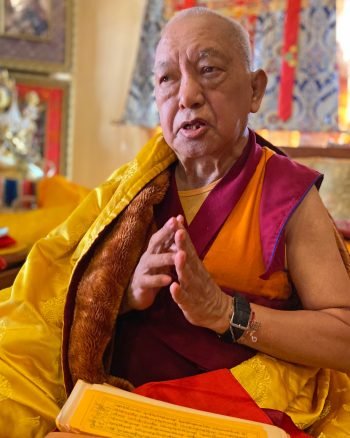
Lama Zopa Rinpoche at Kopan Monastery, January 2022. Photo by Ven. Roger Kunsang.
So you have to look at it that way: the virus is helping you. It becomes the most precious, like a treasure, the most precious wish-granting jewel, so very precious.
In Tibetan we have 424 diseases, and then 360 spirit possessions and 84,000 interferers.
So then there’s no question about this virus. So there are all those things, which are kind of harmful, but everything is transformed. If you think in this way, then everything is supportive for you to achieve enlightenment, and there are no obstacles in your life.
Therefore, the virus is so supportive for you to achieve enlightenment by destroying the self-cherishing thought. So it is like that.
Therefore, you have no obstacles in the life. All the obstacles that you have in your life, the obstacles to practice Dharma, they all become the path to enlightenment. So, there’s no obstacles in the life.
This is how to enjoy the sufferings, or obstacles. That is lojong, the key lojong. It is a very, very, very important lojong point. So try as much as possible, try as much as possible.
So then there are mantras to recite, but you try this, lojong. We need to achieve enlightenment for sentient beings, so we use the obstacles, we utilize them in the path to enlightenment.
So, do lojong as much as possible because our mind is not well trained in lojong. Those who have trained well in lojong, their mind is so happy. How much suffering there is, how much suffering there is wow! So the more suffering there is, the mind is more happy, blissed out.
So since many of us are beginners, try as much as possible to develop this.
Then recite Vajra Armor mantra, Geshe Loden will know it, and it is online. Then recite Black Manjushri mantra.
Thank you very much! See you soon.
With much love and prayers,
Lama Zopa
Colophon: Advice dictated by Lama Zopa Rinpoche at Kopan Monastery, Nepal. Transcribed by Ven. Thubten Munsel, January 21, 2022. Lightly edited by Ven. Holly Ansett and Laura Miller.
Rinpoche has offered extensive valuable advice for practices to be done during the pandemic.
You can find more blogs with short video clips from Rinpoche’s teaching as well as the complete collection of these “Essential Extracts” videos on FPMT.org.
Lama Zopa Rinpoche is the spiritual director of the Foundation for the Preservation of Mahayana Tradition (FPMT), a Tibetan Buddhist organization dedicated to the transmission of the Mahayana Buddhist tradition and values worldwide through teaching, meditation and community service.
2
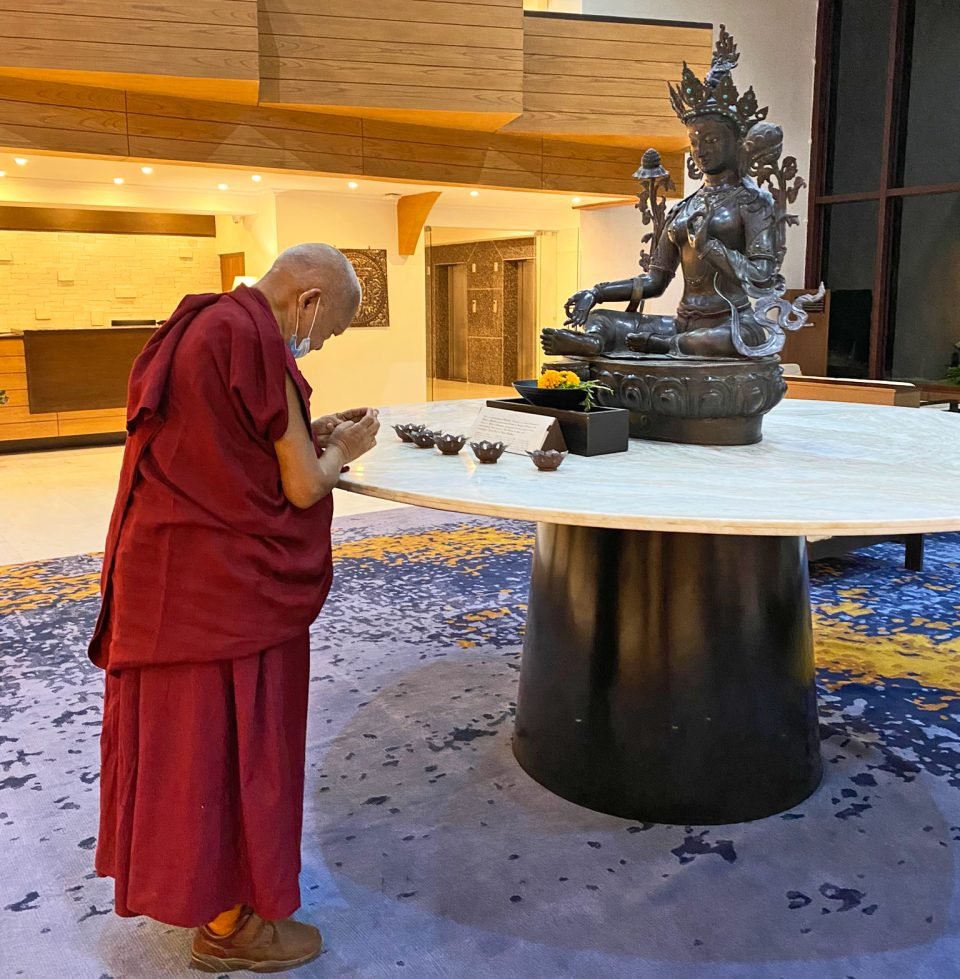
Lama Zopa Rinpoche making prayers to a Tara statue in a hotel in Pokhara, Nepal, December 2021. Photo by Ven. Roger Kunsang.
We can engage in many beneficial activities with our perfect human rebirth, including finding and correctly following a virtuous friend who can guide us to enlightenment. As Lama Zopa Rinpoche teaches, following the guru’s advice is the quickest way to become free from the oceans of samsaric sufferings and achieve enlightenment. Here is an excerpt on this topic from “The Time to Practice is Now,” a detailed summary of the 2020 Thought Transformation Teachings given by Rinpoche. A short Essential Extract video of Rinpoche teaching on following the guru comes after the excerpt.
With this perfect human rebirth we can find a guru, a virtuous friend, who can guide us to enlightenment. Once we have identified someone who possesses the necessary qualities, it is important to correctly follow that guru. To do this, we need to transform our ordinary thought that sees the guru as a normal being into a pure devotional thought that sees the guru as a buddha. This involves a total transformation of our mind that allows us to receive the blessings of the buddhas and gain the realizations of the path to enlightenment. As Rinpoche says, all the holy actions of the buddhas manifest in the guru and every atom of the guru is the numberless buddhas. Thus, correctly following the guru is the quickest way to become free from the oceans of samsaric sufferings and achieve enlightenment.
Unless we have omniscience or very high clairvoyance, we aren’t able to see others’ minds and we can’t tell who is enlightened. The buddhas take different forms to benefit sentient beings depending on the mind of the being. Because at the moment our mind is so obscured, we cannot see a buddha in the aspect of a buddha. The only way we can see the guru is in human form with an ordinary aspect—as having delusions and showing mistaken actions. This is currently the only way for the guru to guide us.
Therefore, when we see mistakes in our guru’s actions, we should think that the guru is purposely showing us the aspect of mistakes because our mind is so obscured and defiled that if the guru didn’t show themselves in this way, we wouldn’t be able to see or communicate with them, and therefore we wouldn’t be able to receive vows, teachings, and so forth from them. In this way, the guru is kinder than all the buddhas for manifesting in an ordinary aspect. Actually, we are fortunate even to have enough good karma to be able to see the guru in human form, rather than as a donkey or mouse! The guru’s kindness is like the limitless sky.
Rinpoche goes over the eight benefits of correctly following the virtuous friend and the eight shortcomings of not doing so. (See chapter 8 in Liberation of the Palm of Your Hand.) We need to understand these well because when our guru is sweet and speaks nice words to us, or gives us presents, we are happy and pleased with them. But if our guru scolds us or shows they are displeased with us, our tendency is to give them up, to throw them away like garbage. Rinpoche asks, How can we achieve enlightenment if we give up the guru when the guru does something that our self-cherishing thought doesn’t like? Instead, we should remember the eight benefits and shortcomings and keep our devotion strong and stable. We should also remember that when the guru scolds us, all the buddhas are scolding us.
A Buddha cannot have anger, it is not possible, so they do this to help purify our negative karma. Likewise, when the guru is praising us, we should rejoice thinking that all the buddhas are so pleased with us.
Rinpoche gives the example of Milarepa, who became enlightened, not only in one life, but in a brief lifetime of degenerate times through the extreme hardships he endured under the guidance of his teacher Marpa. To the outside it looked like he was the most unfortunate person: kicked out of teachings, scolded, and even beaten; but, internally, his bearing these difficulties caused the strongest purification and became the quickest way for him to achieve enlightenment. In fact, when we bear hardships by following our guru’s advice or to fulfill their wishes, it is equivalent to doing the preliminary practices many hundreds of thousands of times. Even if the work is very hard and fraught with problems and difficulties, it becomes something to enjoy the most because it creates the same purification as having done many hundreds of thousands of prostrations, Vajrasattva mantras, mandala offerings, and so forth. It is most amazing.
If we are following the guru’s advice and get sick or experience problems, this is a very good sign because it means many, many eons of suffering in the lower realms are now being purified. Every second that we fulfill the guru’s wishes and follow their advice, our negative karma is being burned up and we are collecting skies of good karma. How much purification happens and how much merit we collect depends entirely on how well we practice correctly following the virtuous friend.
Conversely, if we don’t know the practice of correctly following the guru, we will create the heaviest negative karma every minute. If we disrespect our guru, it becomes disrespect to all the buddhas. After we decide to become a disciple of the guru, if we then belittle the guru, we cannot achieve enlightenment in this life, Rinpoche explains. As such, it is a very heavy negative karma that results in the worst suffering. Therefore, a serious practitioner makes their mind strong and does not allow anything to distract them. No matter what happens they remain determined to fulfill the guru’s wishes and to follow the guru’s advice in order to achieve enlightenment for all sentient beings. Correctly following the virtuous friend becomes the most important thing in one’s life! This is why we must choose our guru very wisely.
To inspire us to correctly follow our guru, Rinpoche explains that by offering service to the guru, we receive more merit than if we were to make offerings to numberless buddhas, Dharma, and Sangha! Even a small gesture like offering a cup of water or a pair of shoes to the guru creates more merit than making offerings to numberless Buddha, Dharma, Sangha, and statues, stupas, and scriptures.
Also, by correctly following the guru, we create the cause to meet a qualified guru in this and all future lifetimes, and to receive the complete and unmistaken Dharma teachings from them. Every second we correctly follow the guru, we create the causes to receive a higher rebirth, and, ultimately, to put an end to the sufferings of samsara and achieve enlightenment. By depending on the guru, we can even achieve enlightenment in a brief lifetime of degenerate times. It is said that even the most foolish person can do this through strong and stable devotion. It is only our lazy mind that makes it difficult to follow the guru’s advice, Rinpoche explains. But by seeing the guru as all the buddhas, and by remembering the guru’s kindness, which is like the limitless sky, we become so happy to follow the advice because we see the incredible importance and the great benefits. So we must make good use of this opportunity!
In this short video Essential Extract, Lama Zopa Rinpoche explains that when we experience difficulties in doing as our guru advised, such as keeping our vows, doing retreat, or working for a center or the FPMT organization, we should know that it is like doing hundreds of thousands of prostrations or mandala offerings. By bearing these hardships, we are purifying our negative karma and collecting extensive merits, which we need to do in order to achieve enlightenment. On the other hand, if we don’t continuously keep our mind in devotion and allow heresy to arise, our mind becomes suffering, like popcorn popping, tak, tak, tak, tak, and we are creating the cause of hell.
Read the transcript of this video extract from Rinpoche’s teaching:
https://fpmt.box.com/s/thhps12d38cky0be88feafj6mzd208fn
You can find more blogs with short video clips from Rinpoche’s teaching as well as the complete collection of these “Essential Extracts” videos on FPMT.org.
Lama Zopa Rinpoche is the spiritual director of the Foundation for the Preservation of Mahayana Tradition (FPMT), a Tibetan Buddhist organization dedicated to the transmission of the Mahayana Buddhist tradition and values worldwide through teaching, meditation and community service.
- Tagged: advice from lama zopa rinpoche, essential extract, essential extract thought transformation teachings, guru devotion, video
28
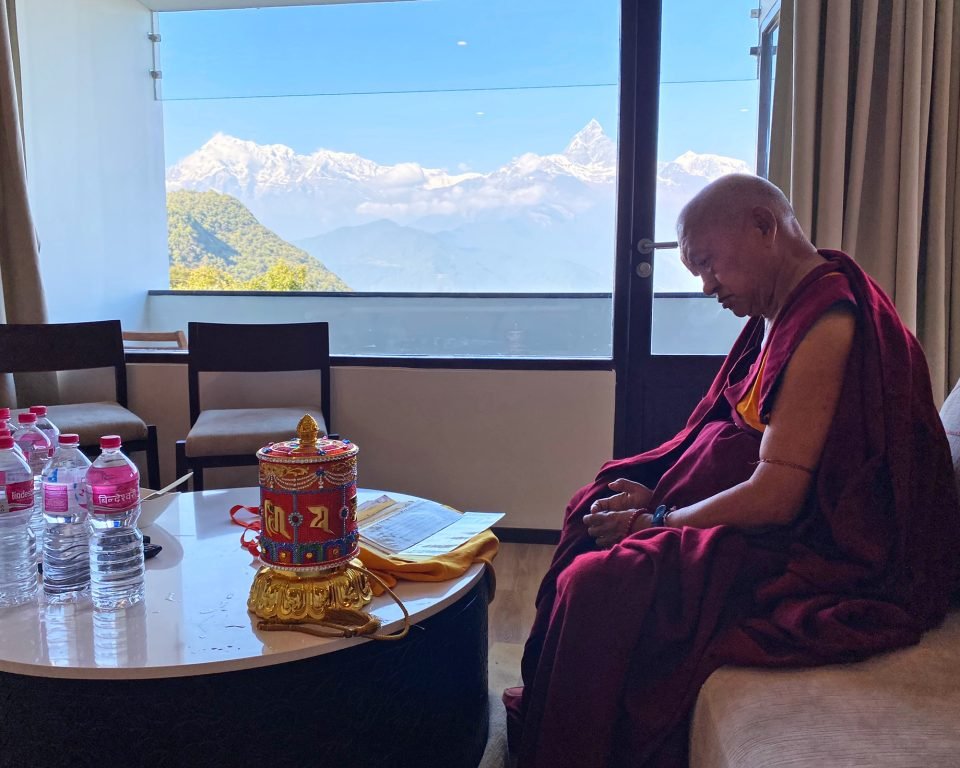
Lama Zopa Rinpoche in a hotel room blessing water that will be used to blessing all the beings in a lake in Pokhara, Nepal, December 2021. Photo by Ven. Roger Kunsang.
In this short intimate clip of advice, Lama Zopa Rinpoche reminds us that the bodhisattva attitude is working for others, which makes life most happy and satisfying. Whether we are benefiting one or numberless sentient beings without self cherishing, living one’s life for others results in happiness for ourselves and eliminates disappointment and depression.
Watch the video clip Working for Others Is the Happiest Life
Lama Zopa Rinpoche has offered many teachings on the bodhisattva attitude, including:
- the booklet Cultivating Mindfulness of Bodhichitta in Daily Activities, in which Rinpoche offers students prayers, visualizations, and advice to help transform daily activities—such as standing up, using the toilet, brushing one’s teeth, dressing, ascending a staircase, or cooking—into causes for enlightenment.
- the module “Bodhichitta Mindfulness,” from the Living in the Path program, which discusses transforming daily activities into Dharma practice and includes video teachings from Lama Zopa Rinpoche as well as an introduction to the topic by Ven. Sarah Thresher, additional readings, access to a discussion forum, and other helpful resources.
- Bodhisattva Attitude: How to Dedicate Your Life to Others, a 266-page book containing verses by Shantideva chosen by Rinpoche to guide us throughout the day; teachings by Rinpoche on four motivations; and an extensive appendix containing materials and practices to support this vital spiritual practice.
You can find more blogs with short video clips from Rinpoche’s teaching as well as the complete collection of these “Essential Extracts” videos on FPMT.org.
Lama Zopa Rinpoche is the spiritual director of the Foundation for the Preservation of Mahayana Tradition (FPMT), a Tibetan Buddhist organization dedicated to the transmission of the Mahayana Buddhist tradition and values worldwide through teaching, meditation and community service.
25

Lama Zopa Rinpoche and Khadro-la offering prayers at one of the Ashoka Stupas in Patan, Nepal, December 2021. Photo by Ven. Roger Kunsang.
When people or situations disturb our minds, it’s an opportunity to notice how well—or not well—we are practicing Dharma. For example, does our mind become angry or do we have compassion when someone makes a mistake or hurts us? As Lama Zopa Rinpoche advises, if we have anger, then we should direct our attention to seeing that anger as the enemy and not the person who we think caused it. In fact, we should be grateful to that person for giving us the opportunity to further develop our Dharma practice.
Here is an excerpt of Rinpoche’s teachings on this topic from “The Time to Practice is Now,” a detailed summary of the 2020 Thought Transformation Teachings given by Rinpoche. Then following the excerpt is a short video of Rinpoche teaching on this topic.
Happiness or problems are in our control, Lama Zopa Rinpoche says. It depends on whether we think in a positive or negative way. If we think in a negative way, mountains of problems arise, resulting in losing our appetite, not sleeping, and even committing suicide. To the contrary, if we avoid anger, there is no enemy in the world. So in that way, it is up to us whether or not we have enemies. To help us develop patience, Rinpoche offers several methods we can use to change our way of thinking to help us overcome our anger and remain patient when others treat us badly.
Instead of getting angry at a person for making mistakes, we can think that it is ignorance that is causing their actions. Instead of thinking, “That person is bad,” we can think, “I need to help that person, especially to reduce their ignorance.” We can also remember their kindness instead of focusing on their mistakes. Then we can have compassion for the person instead of anger.
When a mosquito is buzzing around us, or someone harms us, we can use this as an opportunity to examine whether or not we were really practicing Dharma when we recited many mantras and prayers and have done many retreats. For example, when someone is angry, scolding, or disrespecting us, we can see whether or not we are practicing Dharma by how much we can dedicate our merits for that person. We can also check whether our mind is kind and compassionate and we generate patience or forgiveness, or we get angry and want to harm them.
Rinpoche suggests that instead of getting angry at our present situation, which causes us to be reborn in hell and is the heaviest suffering in samsara, why don’t we get angry at the anger? Our real enemy is the anger. The anger is not outside, not coming from those who harm us; it is in our mind. Do we want to be reborn in hell and suffer? The answer is no. What causes that is anger. So, logically, we must give up anger.
Obstacles, disturbing situations, undesirable conditions—all persuade us to practice virtue. Therefore we need to complete the paramita of patience to achieve enlightenment. Someone who treats us badly is our practical teacher of patience, our practical guru of patience. Only the sentient beings who harm us and get angry at us, the ones we call “enemy,” actually help us to practice the paramita of patience and put into practice the teachings we have received. By practicing patience we can overcome anger and not only achieve liberation from samsara, but achieve enlightenment, the infinite qualities of the holy body, speech, and mind of a Buddha, with which we can do perfect work for sentient beings. By thinking in this way, we can see that this person who is our “enemy” is actually unbelievably kind and incredibly precious in that they help us to achieve enlightenment. How kind they are!
From our own side, we can practice rejoicing when someone harms us; but from the side of the other person, they should practice self-discipline. Because we are practicing rejoicing at the situation, it might look as though that other person can do whatever they wish, including harming us. Rinpoche clarifies, it is not like that. If their behavior is harming others, that person should stop doing it. However, while we can’t control what someone else does, we can control what we do. By rejoicing and keeping a happy mind, our body and mind remain relaxed and comfortable. By practicing self-discipline and contentment, we can bring peace to the world rather than being like a firecracker— full of anger and jealousy.
In this video clip, Lama Zopa Rinpoche explains how the person who harms us, who criticizes us, who is angry with us, our enemy, allows us to complete the practice of patience and achieve enlightenment. No one else, not our friends or strangers, gives us this precious opportunity. By practicing patience and overcoming anger, we can achieve the infinite qualities of an enlightened being and do perfect work for sentient beings. Therefore, our so-called enemy gives us skies of kindness. We can’t repay this kindness by offering them the sky filled with dollars or wish-granting jewels. We can’t even repay their kindness by offering them the whole world. Their kindness is unbelievable.
Read the transcript of this video extract from Rinpoche’s teaching:
https://fpmt.box.com/s/tqjstohvj6dcyh0c1xph6k9z3r513hkk
You can find more blogs with short video clips from Rinpoche’s teaching as well as the complete collection of these “Essential Extracts” videos on FPMT.org.
Lama Zopa Rinpoche is the spiritual director of the Foundation for the Preservation of Mahayana Tradition (FPMT), a Tibetan Buddhist organization dedicated to the transmission of the Mahayana Buddhist tradition and values worldwide through teaching, meditation and community service.
- Tagged: advice from lama zopa rinpoche, essential extract, essential extract thought transformation teachings, impermanence and death, patience, video
19
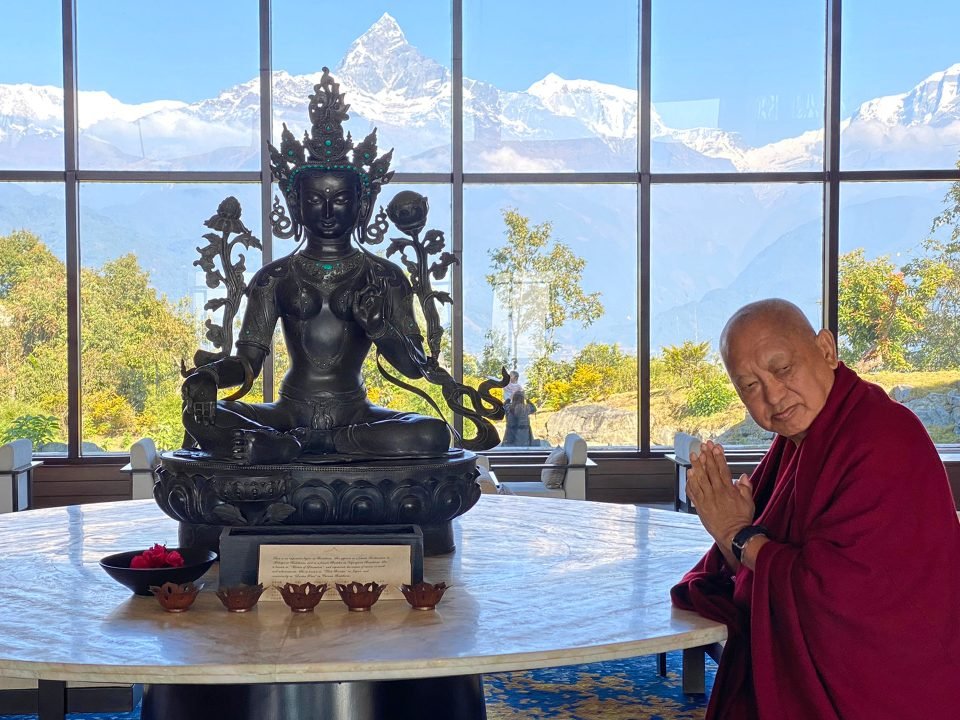
Lama Zopa Rinpoche with a Tara statue in a hotel in Pokhara, Nepal, December 2021. Photo by Ven. Roger Kunsang.
Our time to practice Dharma is fleeting. We don’t know when we will die. Lama Zopa Rinpoche regularly encourages us to think about impermanence and death so we don’t procrastinate doing our Dharma practice. Below is an excerpt on this topic from “The Time to Practice is Now,” a detailed summary of the 2020 Thought Transformation Teachings offered by Rinpoche from Kopan Monastery in Nepal. Following the excerpt is a short video on this topic from these teachings.
Lama Zopa Rinpoche explains that meditating on death and impermanence is what controls and subdues our mind. He reminds us of the important points about death to remember and meditate on.
Death is definite. Everyone who is alive now will one day be dead. We are all in the process of dying. From the moment we are born, we are constantly running toward death. In the morning we could be involved in conversations and other activities, and by the evening we could be dead. This includes famous people and holy beings—all beings who are living now, at some point in the future will no longer be here, just their names will remain. But while we continuously see people around us dying of cancer, or currently from this virus, we never relate it to ourselves—we never think, “Just like them, I’m going to die.” To make sure that we don’t take our life for granted and waste it, therefore we need to remember how death is definite, thinking, “Sooner or later, I too will not be here.”
Although death is definite, the time of our death is uncertain. We are unbelievably fortunate to still be alive today. So many people died last night, but we are still alive. Although we can die at anytime, the best thing to think is that we could die today or, at most, we could die tomorrow. In this way, we will use every moment we have left to practice Dharma.
At the time of death nothing can benefit us other than Dharma. The family and friends that we love can’t come with us, nor can our wealth or possessions—not even our precious body that we cherish so much. We can’t carry even one atom with us. It is only our practice of the holy Dharma that can benefit us at the time of death, nothing else.
Remembering death and impermanence encourages us to practice right now. There is no time to waste. We don’t think about death to develop a fear of dying; we do it to encourage ourselves to practice Dharma without delay, to not put it off until we get old. By continually being aware of death and practicing Dharma, the best Dharma practitioners are able to die happy, the middling ones are able to die without sadness, and even the poorest ones are able to die without regret, Rinpoche explains.
“Among all the things to remember, the best is remembering impermanence-death. It reminds you to practice Dharma. Not just to practice Dharma in this life, but to practice Dharma—since when death will occur is not definite,” Lama Zopa Rinpoche advises.
Watch the Essential Extract “Remembering Impermanence-death, Everything You Do Becomes Holy Dharma”:
In this video Essential Extract, Lama Zopa Rinpoche explains a quote by Milarepa that says that by remembering impermanence and death, we will conquer the mara of laziness. If, on the other hand, we don’t remember that we could die at any time, our main aim in life will be to achieve happiness in this life, today, and right now! Due to this procrastinating, we risk wasting our whole life. Milarepa also says that by remembering impermanence and death, whatever we do becomes Dharma, not only receiving teachings and meditating, but even activities such as eating, walking, working, and sleeping.
Read the transcript of this video extract from Rinpoche’s teaching:
https://fpmt.box.com/s/8doo87er18je0tg1vav6dgfpgusu55hx
You can find more blogs with short video clips from Rinpoche’s teaching as well as the complete collection of these “Essential Extracts” videos on FPMT.org.
Lama Zopa Rinpoche is the spiritual director of the Foundation for the Preservation of Mahayana Tradition (FPMT), a Tibetan Buddhist organization dedicated to the transmission of the Mahayana Buddhist tradition and values worldwide through teaching, meditation and community service.
- Tagged: advice from lama zopa rinpoche, death and dying, essential extract, essential extract thought transformation teachings, impermanence and death, video
17
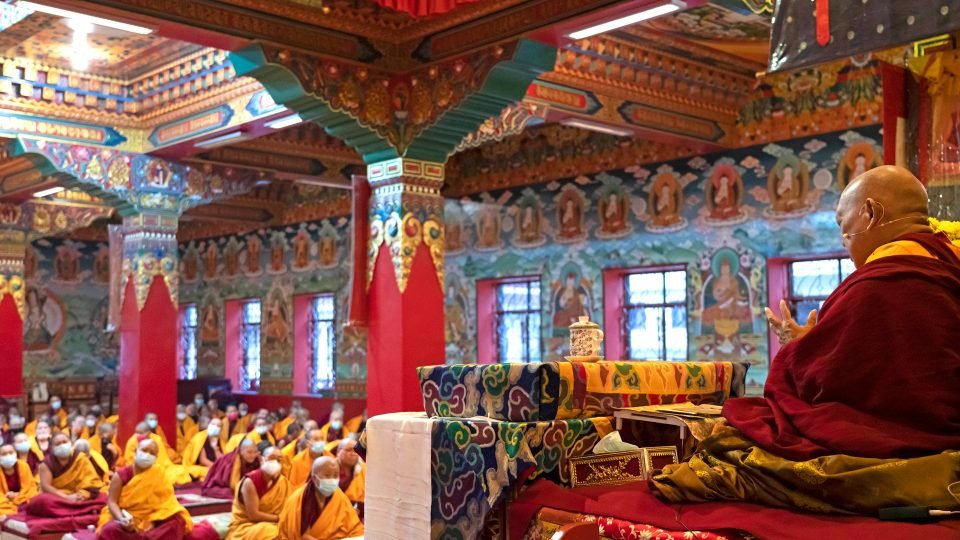
Lama Zopa Rinpoche teaching at Khachoe Ghakyil Nunnery, Kopan Monastery, Nepal, November 2021. Photo by Ven. Lobsang Sherab.
Since our last update, Lama Zopa Rinpoche has remained in Nepal, concluding his teachings at Kachoe Ghakyil Ling Nunnery, celebrating a birthday, visiting Pokhara and Patan for a variety of auspicious activities, and taking a pause from teachings. We invite you to rejoice in Rinpoche’s compassionate service to others and enjoy some new photos we have made available.
Kopan Monastery and Kachoe Ghakyil Ling Nunnery
Lama Zopa Rinpoche’s seventy-sixth birthday was celebrated on December 3 at Kopan Monastery. The festive day included the offering of a large Tara statue to Rinpoche during the early morning Sixteen Arhats long life puja. The statue was offered to Rinpoche on behalf of the entire FPMT organization. Also, a special lunch was prepared for all Kopan monks, nuns, and guests, which included presenting a birthday cake to Rinpoche, young monks singing “Happy Birthday,” and short plays. You can read more about these auspicious activities.
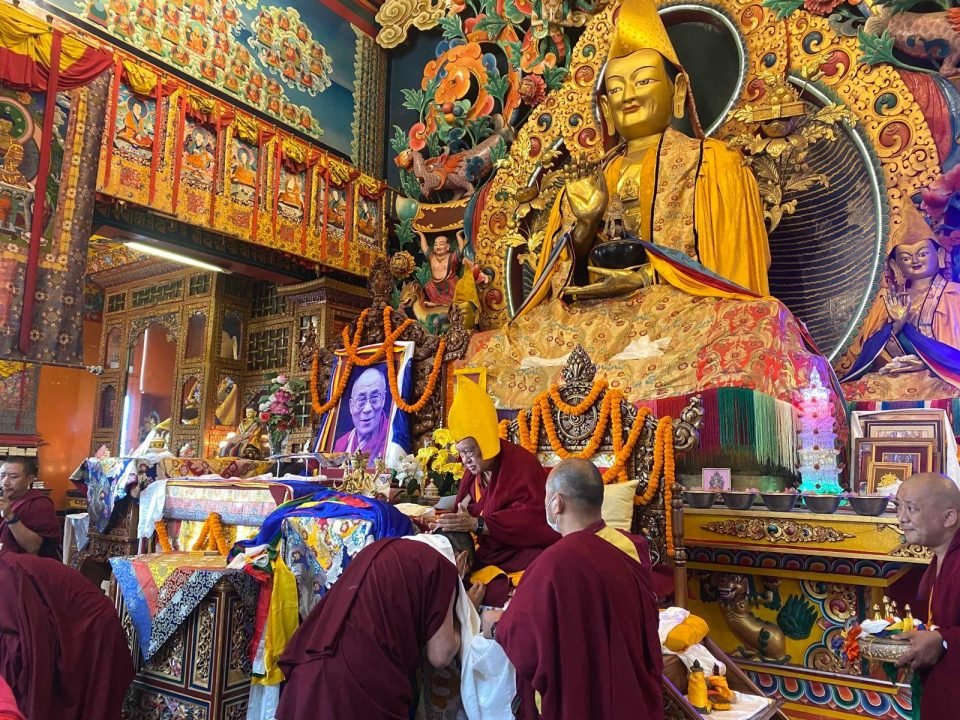
Lama Zopa Rinpoche during the Sixteen Arhats puja offered to him on his birthday, Kopan Monastery, Nepal, December 2021. Photo by Ven. Topgye.
Starting on December 10 and over the course of a few days Lama Zopa Rinpoche offered Yamantaka initiation at Kopan Monastery.
For nearly two months, Lama Zopa Rinpoche taught at Kachoe Ghakyil Ling Nunnery. The teachings ended right before the Christmas holiday on December 22. These teachings were translated into Nepali from Tibetan, providing a rare opportunity for Nepali people to have access to Rinpoche’s teachings in their own language and were made available on the FPMT Tibetan YouTube channel. Among many other topics, Rinpoche focused on how to distinguish between holy Dharma and worldly Dharma, and how to make sure all actions become holy Dharma.
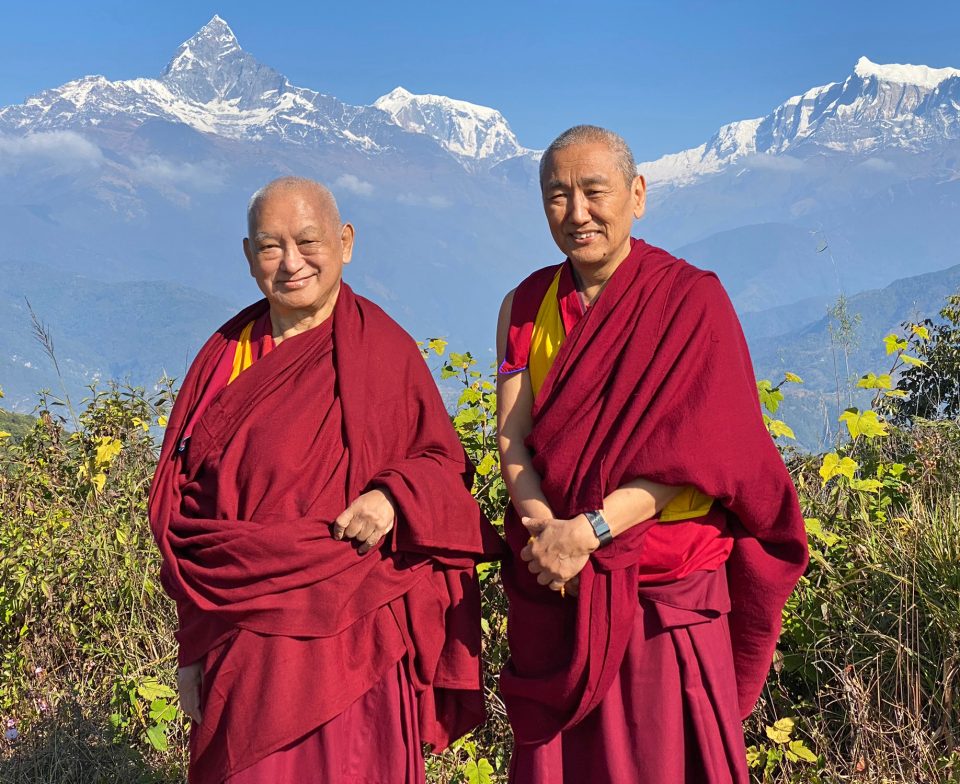
Lama Zopa Rinpoche and Khen Rinpoche Geshe Chonyi, the abbot of Kopan, Pokhara, Nepal, December 2021. Photo by Ven. Roger Kunsang.
Pokhara and the Ashoka Stupas in Patan
Following the conclusion of the teachings at the nunnery, Rinpoche traveled to Pokhara, which is Nepal’s second most populated city after Kathmandu. Located about 120 miles west and north of Kathmandu, Pokhara is a major tourist destination and is where the FPMT center Ganden Yiga Chözin Buddhist Meditation Centre is located. While there, Rinpoche used every moment to benefit others—offering Heruka incense puja, a teaching at the center, and blessing the fish and all beings in the lake.
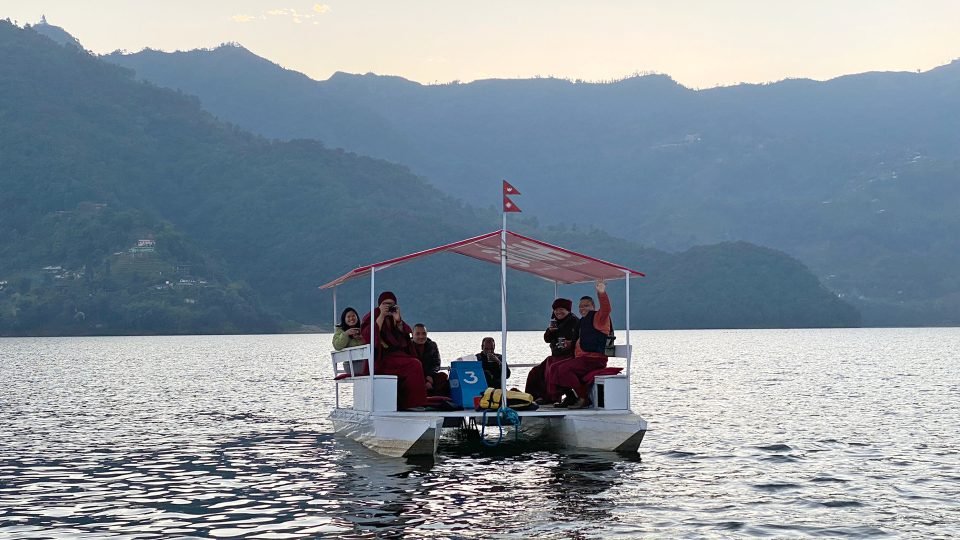
Rinpoche with Khen Rinpoche Geshe Chonyi, monks, and students blessing the sentient beings in the lake, Pokhara, Nepal. Photo by Ven. Roger Kunsang.
At the new year, Rinpoche traveled to Patan, which is now the third largest city in Nepal, located just south of Kathmandu. There Rinpoche and Rangjung Neljorma Khadro Namsel Drönme (Khadro-la) consecrated and offered prayers in front of three of what are known as the “Ashoka Stupas.” These ancient stupas are located around the historic city of Patan, where trade routes cross the city going towards India and Tibet. The western, southern, and eastern stupas are still in the form of grassy mounds although later additions were added by both Newari and Tibetan Buddhist. The northern stupa was renovated and plastered over half a century ago and looks more like Boudhanath Stupa. Nobody knows how old these stupas are or what is contained inside them because they have never been excavated. Legend tells us that either King Ashoka, or his daughter, or his emissaries came to the Kathmandu Valley and constructed them.
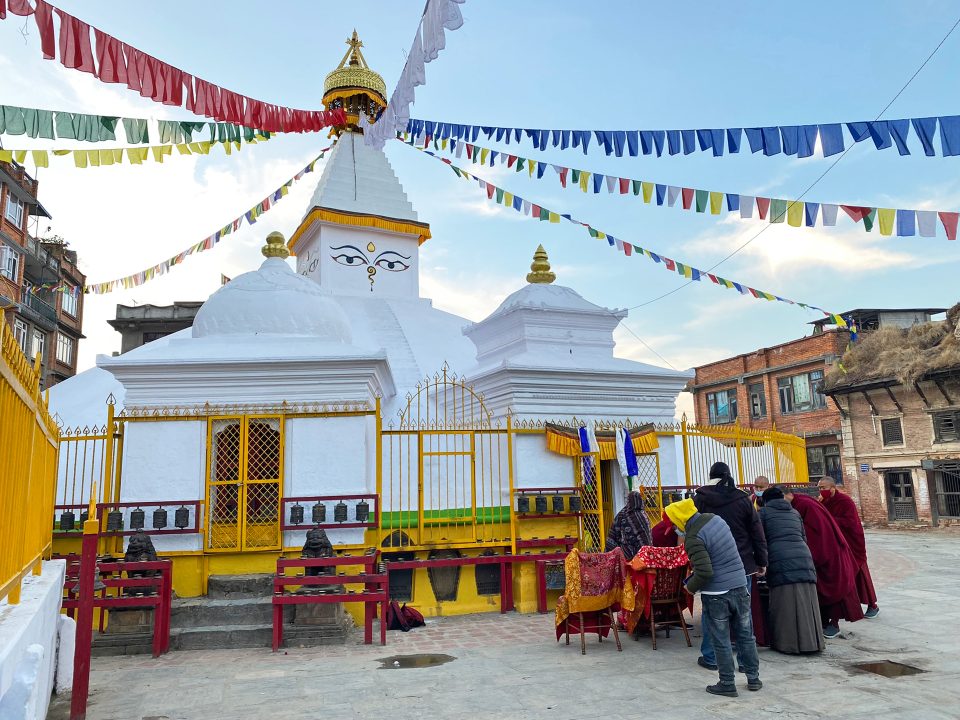
Ibahi Thur, the north Ashoka Stupa, where Rinpoche and Khadro-la offered prayers and did consecration, Patan, Nepal. Photo by Ven. Roger Kunsang.
King Ashoka was the warrior king, who famously converted to Buddhism and took the relics from seven of the original stupas constructed after the Buddha passed away, which he then distributed in stupas constructed throughout the Indian subcontinent. King Ashoka is said to have constructed or sponsored 84,000 stupas containing Buddha’s ashes. He visited Lumbini to worship at the birthplace of the Buddha in 249 BCE—a fact that was verified upon excavation of the site by the British, who uncovered an inscribed pillar recording the visit. If the Ashoka Stupas were constructed on the command of King Ashoka they are very old.
The northern stupa is called Ibahi Thur; the eastern stupa is Teta Thur; the southern stupa is Lagan Thur; and the western stupa is Pulchowk Thur. Although three were originally constructed outside the historical boundaries of Patan, the city has recently become so developed that they are now mostly on busy roads or surrounded by buildings. There is also a central stupa, the Pimbahal Stupa, which is quite different in style, since it was destroyed in 1350 CE during an attack by Muslim invaders from Bengal and subsequently restored.
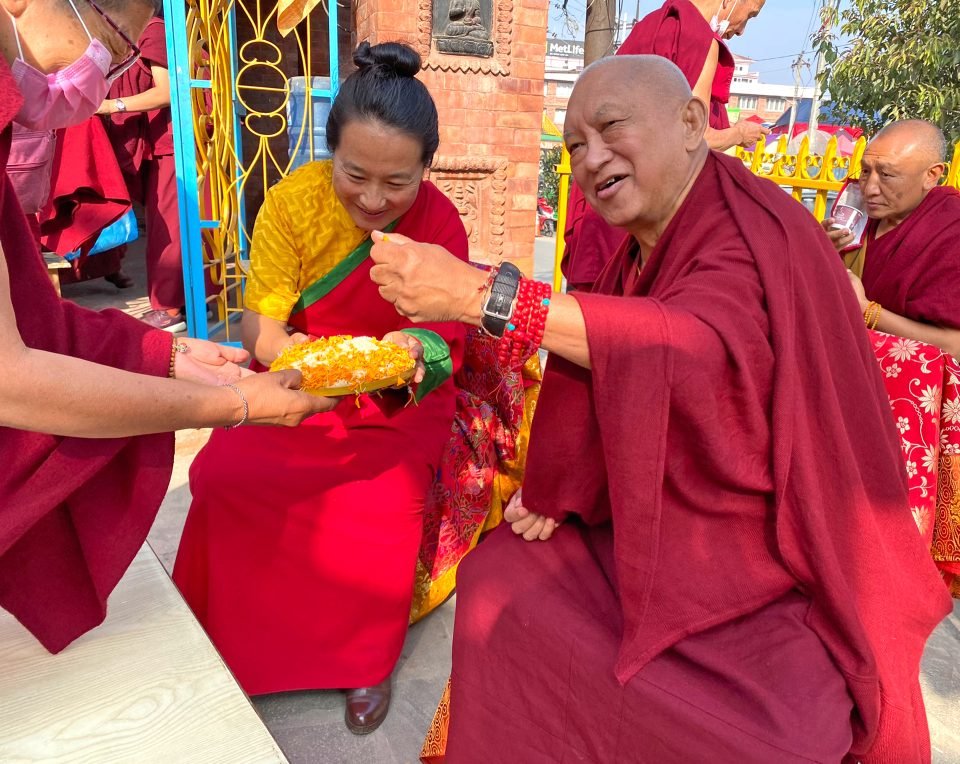
Rinpoche and Khadro-la consecrating one of the Ashoka Stupas and offering prayers, Patan, Nepal. Photo by Ven. Roger Kunsang.
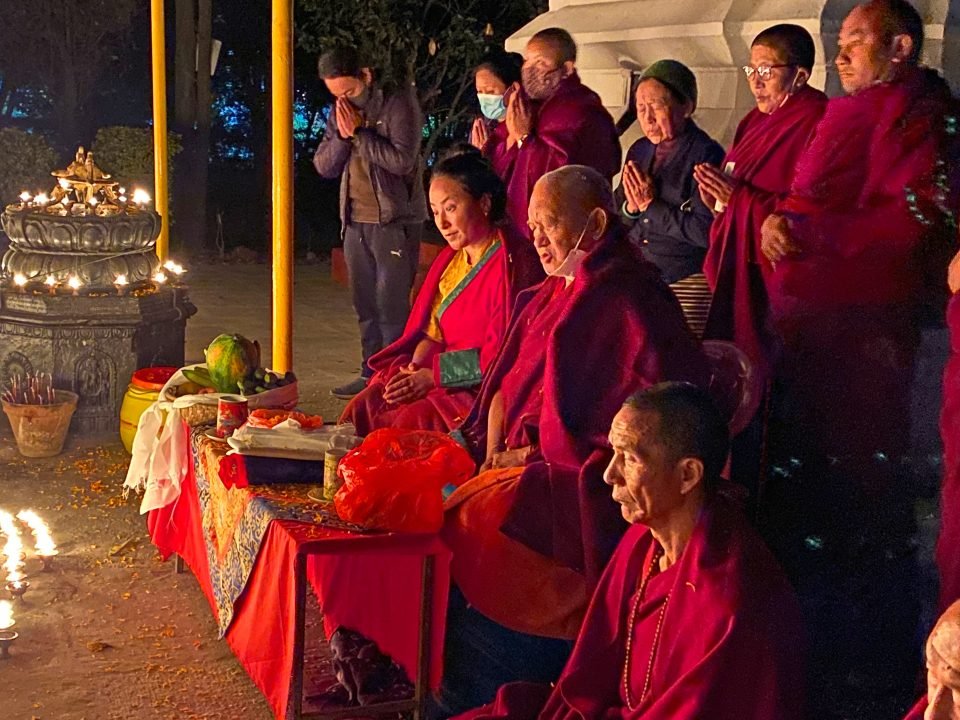
Rinpoche and Khadro-la consecrating one of the Ashoka Stupas and offering prayers, Patan, Nepal. Photo by Ven. Roger Kunsang.
Stay Connected and Please Rejoice!
Rinpoche will be taking a break from teachings, but we look forward to their continuation in the near future, and we will share new videos and summaries as they become available. Meanwhile, we will continue to offer excerpts from Rinpoche’s teachings of recent years.
Please rejoice in Rinpoche’s continued auspicious activities, benefiting others at every opportunity. We have created a new photo album of Rinpoche, including activities we didn’t mention above, which we invite you to enjoy.
Visit the November–December 2021 photo album:
https://fpmt.org/teachers/zopa/gallery/nepal-november-december-2021/
Lama Zopa Rinpoche is the spiritual director of the Foundation for the Preservation of Mahayana Tradition (FPMT), a Tibetan Buddhist organization dedicated to the transmission of the Mahayana Buddhist tradition and values worldwide through teaching, meditation and community service.
Thanks to Ven. Sarah Thresher for her research on the Ashoka Stupas.
- Tagged: ashoka stupas, holy objects, kopan monastery, lama zopa rinpoche, lama zopa rinpoche activities, nepal, patan, pokhara, stupas
10
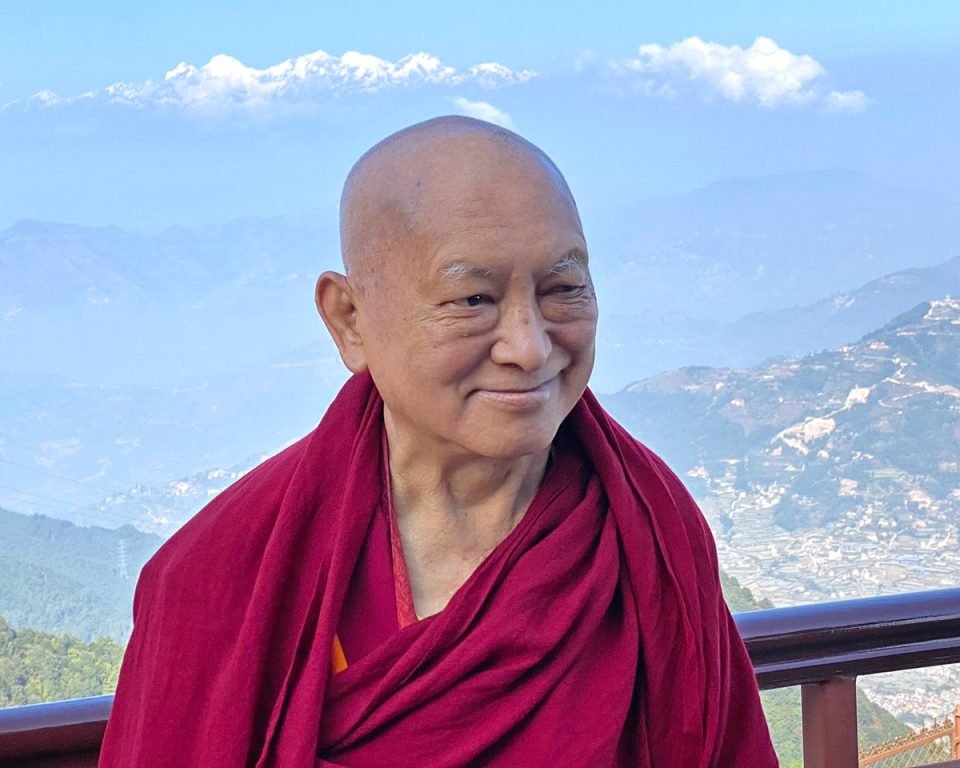
Lama Zopa Rinpoche during a visit to the Chandragiri Hill Resort, Nepal, November 2021. Photo by Ven. Roger Kunsang.
The Six Perfections: The Practice of the Bodhisattvas by Lama Zopa Rinpoche has recently been released in a paperback edition. In the book, Rinpoche walks us through the six perfections, which are a key Mahayana Buddhist teaching. Here’s an excerpt from Rinpoche’s teaching on the perfection of patience:
There is nothing pleasant at all about anger. Irritation, agitation, impatience, sullenness, spite—all these sorts of negative emotions overwhelm us and refuse to give us one moment’s peace, whereas when we have patience, we have genuine peace. There is no question of which is preferable. The frustrated, unhappy mind is the fuel that can easily grow into anger. Until we have learned to overcome that anger with patience, it will destroy any happiness we have.
It’s not that anger and hatred are weak minds. With hatred our mind is incredibly focused on the object of our hatred and how to destroy it. We should turn that strength around to destroy the real enemy, focusing all our attention on what is really causing us such unhappiness—our own anger. We need to destroy it completely with patience.
We don’t have to become angry when an enemy tries to harm us or when adverse situations occur. It’s impossible to avoid problems, but when we analyze such situations, we will see that there is no reason for becoming unhappy. Unless we can generate a happy mind, how can we renounce the unhappy one? We therefore need to think well on the benefits of voluntarily accepting suffering and make a strong determination to not allow anger and frustration to arise, no matter what happens around us.
It is very easy to let a day go by without practicing patience, then a week, a month, a year. Before we know it, our whole life has gone and then, suddenly, unexpectedly, death happens and we have never developed patience in our mind, despite all the teachings we have studied and retreats we have done. At the time of death it’s too late to regret not developing patience.
What we can do now in a very practical way is to watch our mind, and the moment it is disturbed by somebody or something, by understanding the terrible effects of anger, we determine to not allow even a moment of anger to arise. We can make a plan to do this for a certain time each day and gradually increase it. If we train our mind in patience in that way, doing whatever we can to overcome any angry thought that arises, by keeping at it, change will definitely happen, year by year. Seeing how there is so much more peace now that the angry mind does not arise gives us the determination to practice patience even more. Then, thinking back on how we once would have become angry from one sharp word from a colleague at work or from the noise of branches tapping on our window disturbing our sleep, we will wonder why we ever got so angry. It is just a matter of practice.
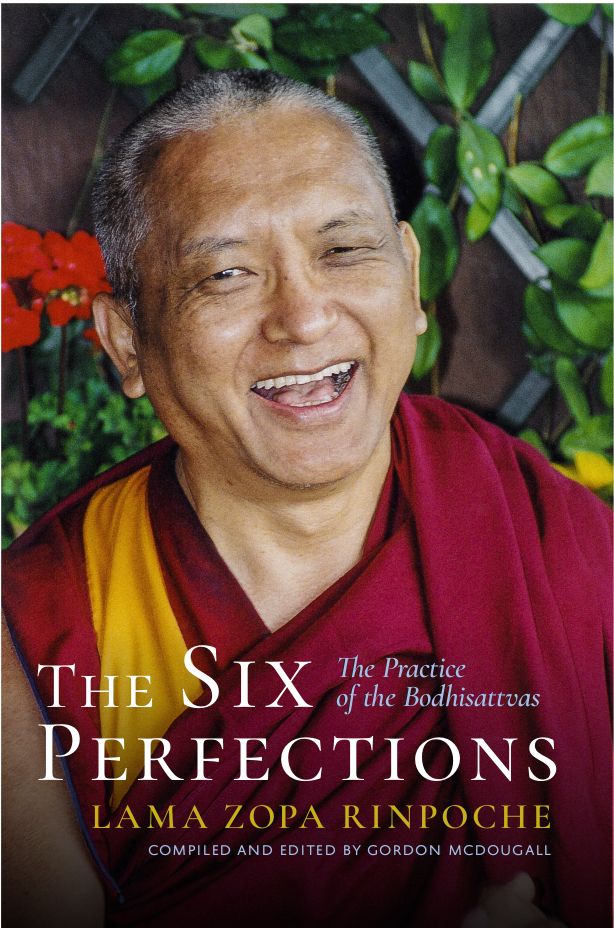
Cover of Lama Zopa Rinpoche’s book The Six Perfections
Learn more about Lama Zopa Rinpoche’s The Six Perfections: The Practice of the Bodhisattvas, including ordering information for the paperback and hardcover editions, on Wisdom Publication’s website:
https://wisdomexperience.org/product/the-six-perfections/
You can also find The Six Perfections as an ebook in the Foundation Store (shop.fpmt.org).
Watch the ongoing video series Lama Zopa Rinpoche’s Teachings on Thought Transformation and find links to videos in translation, transcripts, MP3s, additional practice advice, and more.
Lama Zopa Rinpoche is the spiritual director of the Foundation for the Preservation of Mahayana Tradition (FPMT), a Tibetan Buddhist organization dedicated to the transmission of the Mahayana Buddhist tradition and values worldwide through teaching, meditation and community service.
3
The Real Meaning of Practicing the Dharma
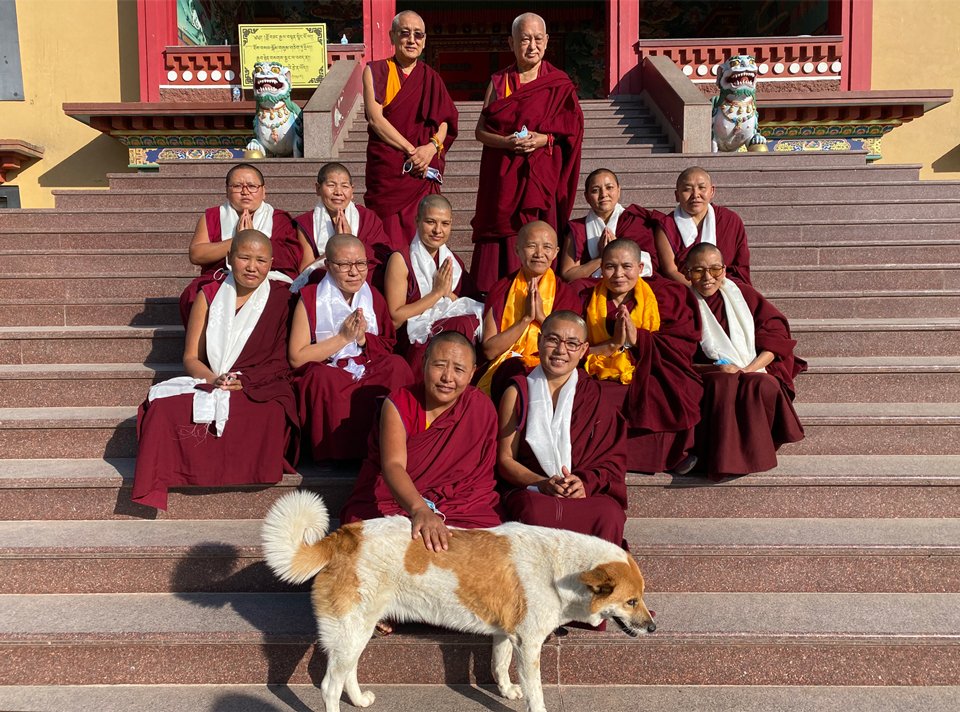
Lama Zopa Rinpoche and Khen Rinpoche Geshe Chonyi, nunnery abbot, with nuns who have completed their studies at Khachoe Ghakyil Ling, Nepal, November 2021. Photo by Ven. Roger Kunsang.
In the following short video from a teaching given in Madrid, Spain, in 2018, Lama Zopa Rinpoche discusses what it means to truly practice Dharma.
At beginning of this video, Rinpoche recalls how, many years ago while staying at Lawudo in Nepal, he read the text “At the Very Beginning, Thought Transformation Opening the Door of Dharma.” Due to reading this text, Rinpoche reviewed his life to check whether he had practiced actual Dharma and realized that nothing he had done up to that point was Dharma.
In the video, Rinpoche then recommends to students that if they are planning to do retreat they should familiarize themselves with this text. (Rinpoche mentions his books The Door to Satisfaction and How to Practice Dharma for more on this topic.)
Rinpoche then tells the story of a practitioner who met Gyalwa Dromtonpa, the translator of Atisha in Tibet. Each time this student met Dromtonpa, regardless of whether the student had read a text, meditated, or circumambulated a stupa, Dromtonpa told the student that what he had done was good, but it would be even better to practice Dharma. Eventually the student asked what Dromtonpa meant by that. Dromtonpa said, “Renounce this life.”
Rinpoche explains how all our problems come from our attachment to this life, and that our attachment creates unbelievable suffering for us. It leads to rebirth in lower realms. So we must renounce our attachment, Rinpoche says, we must give up the root of our problems.
“That is the start of Dharma practice,” Rinpoche says. “Then on the basis of that you develop [your practice]. On the basis of that, you achieve enlightenment. You come to omniscient mind. Then you benefit numberless sentient beings and bring them to enlightenment.”
What it means to practice Dharma is the first and most important thing to know, Rinpoche explains. Otherwise, there is the danger that the time that you do retreat or stay in a monastery and study is wasted when you don’t know how to practice holy Dharma.
Watch this teaching in the video “The Real Meaning of Practicing the Dharma”:
The above video is extracted from a teaching given on October 21, 2018, in Madrid, Spain. You can find more blogs with short video clips from Rinpoche’s teaching as well as the complete collection of these “Essential Extracts” videos on FPMT.org.
Watch videos from the ongoing series Lama Zopa Rinpoche’s Teachings on Thought Transformation and find links to transcripts, MP3s, additional practice advice, and more. Read an in-depth summary of Rinpoche’s thought transformation teachings given in 2020 in the Mandala 2021 article “The Time to Practice Is Now.”
Lama Zopa Rinpoche is the spiritual director of the Foundation for the Preservation of Mahayana Tradition (FPMT), a Tibetan Buddhist organization dedicated to the transmission of the Mahayana Buddhist tradition and values worldwide through teaching, meditation and community service.
31
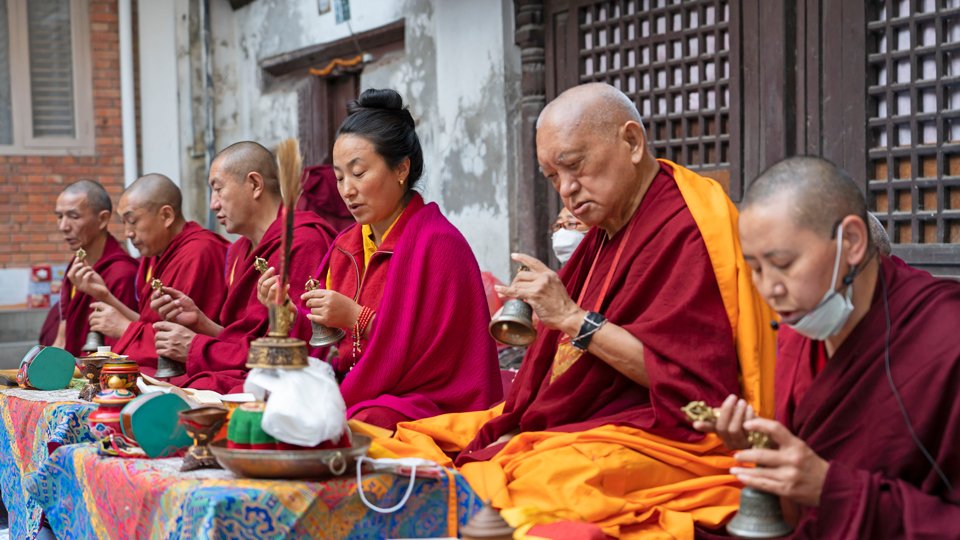
Lama Zopa Rinpoche and Khadro-la offering Tara Puja at Tara Temple in Kathmandu, Nepal, November 2021. Photo by Ven. Lobsang Sherab.
With the new year approaching, many of us are reflecting on the past year— rejoicing in the blessings we received, and also assessing mistakes we have made. Fortunately, we have methods at our disposal to help us purify negative karma we have created. We can utilize these practices daily, and also as a way to enter the new year with a renewed sense of resolve to be the best versions of ourselves, so we can be of most benefit to others.
During the ongoing video Thought Transformation Teachings that Lama Zopa Rinpoche has been offering from Kopan Monastery in Nepal, Rinpoche has, on several occasions, talked about purification practice. In “The Time to Practice is Now,” a detailed, overarching summary of the 2020 teachings published in Mandala, Rinpoche discusses the many benefits of having a perfect human rebirth, including how it grants us the opportunity to purify negative karma. Here’s an excerpt from this summary:
Rinpoche explains that having this one-time opportunity makes us unbelievably fortunate—a perfect human rebirth is more precious than the whole sky filled with wish-granting jewels. This is because even skies of wish-granting jewels don’t have the power to purify our negative karma and save us from the lower realms, nor can they give us liberation from samsara and enlightenment, but having a perfect human rebirth can do this.
We have been creating negative karma from beginningless rebirths, which is why it is so important to do purification practices in this life—before our negative karma ripens. Once it ripens, there’s nothing we can do; we must experience the result. Therefore, we need to do a purification practice every day. There are many practices we can do for purification, including Vajrasattva practice, prostrations to the Thirty-Five Confession Buddhas, and others. Although these formal purification practices are extremely effective in purifying our negative karma, Rinpoche explains that the most powerful thing we can do to purify our negative karma is to follow our guru’s advice and please our guru. But if we don’t realize how valuable and important these practices are and that having a perfect human rebirth gives us the perfect opportunity to do them, we might think it is better to spend our time at the beach swimming in the water like a fish!
Watch Rinpoche discuss the importance of purification practices in “Purify Now Because You Can Die Anytime”:
Watch the ongoing video series Lama Zopa Rinpoche’s Teachings on Thought Transformation on FPMT.org and find links to transcripts, MP3s, additional practice advice, and more. Read our summary article on Rinpoche’s 2020 teachings “The Time to Practice Is Now.”
You can find resources to support your purification practice on the Practices for Purification page:
https://fpmt.org/education/prayers-and-practice-materials/purification/
Lama Zopa Rinpoche is the spiritual director of the Foundation for the Preservation of Mahayana Tradition (FPMT), a Tibetan Buddhist organization dedicated to the transmission of the Mahayana Buddhist tradition and values worldwide through teaching, meditation and community service.
- Home
- News/Media
- Study & Practice
- About FPMT Education Services
- Latest News
- Programs
- New to Buddhism?
- Buddhist Mind Science: Activating Your Potential
- Heart Advice for Death and Dying
- Discovering Buddhism
- Living in the Path
- Exploring Buddhism
- FPMT Basic Program
- FPMT Masters Program
- FPMT In-Depth Meditation Training
- Maitripa College
- Lotsawa Rinchen Zangpo Translator Program
- Universal Education for Compassion & Wisdom
- Online Learning Center
- Prayers & Practice Materials
- Overview of Prayers & Practices
- Full Catalogue of Prayers & Practice Materials
- Explore Popular Topics
- Benefiting Animals
- Chenrezig Resources
- Death & Dying Resources
- Lama Chopa (Guru Puja)
- Lama Zopa Rinpoche: Compendium of Precious Instructions
- Lama Zopa Rinpoche: Life Practice Advice
- Lama Zopa Rinpoche Practice Series
- Lamrim Resources
- Mantras
- Prayer Book Updates
- Purification Practices
- Sutras
- Thought Transformation (Lojong)
- Audio Materials
- Dharma Dates – Tibetan Calendar
- Translation Services
- Publishing Services
- Teachings and Advice
- Find Teachings and Advice
- Lama Zopa Rinpoche Advice Page
- Lama Zopa Rinpoche: Compendium of Precious Instructions
- Lama Zopa Rinpoche Video Teachings
- ༧སྐྱབས་རྗེ་བཟོད་པ་རིན་པོ་ཆེ་མཆོག་ནས་སྩལ་བའི་བཀའ་སློབ་བརྙན་འཕྲིན།
- Podcasts
- Lama Yeshe Wisdom Archive
- Buddhism FAQ
- Dharma for Young People
- Resources on Holy Objects
- Ways to Offer Support
- Centers
- Affiliates Area
- Teachers
- Projects
- Charitable Projects
- Make a Donation
- Applying for Grants
- News about Projects
- Other Projects within FPMT
- Support International Office
- Projects Photo Galleries
- Give Where Most Needed
- FPMT
- Shop
Translate*
*powered by Google TranslateTranslation of pages on fpmt.org is performed by Google Translate, a third party service which FPMT has no control over. The service provides automated computer translations that are only an approximation of the websites' original content. The translations should not be considered exact and only used as a rough guide.If you want to be loved, love others first.







